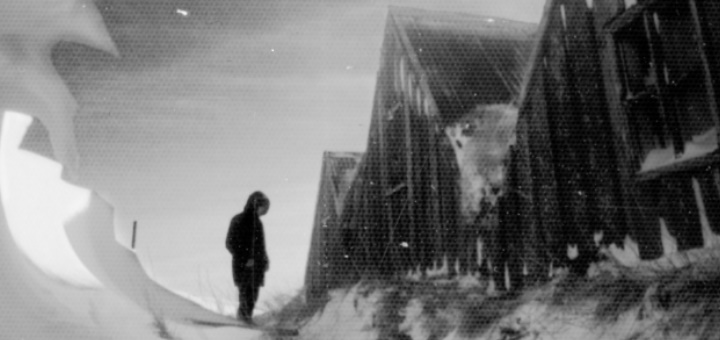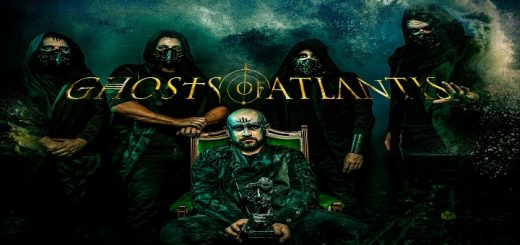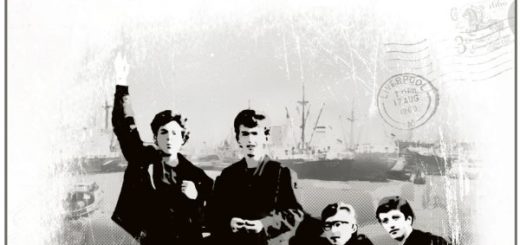Guðmundur Óli Pálmason (KATLA:) im Interview

Am 13. November 2020 veröffentlichen KATLA. ihr zweites Album “Allt þetta helvitis myrkur”. Da mich die Musik und auch die Arbeit als ein Projekt, das Guðmundur Óli Pálmason und Einar Thorberg Guðmundsson allein bzw. mit Beteiligung von Freunden und Familie umgesetzt haben, beeindruckt haben, nutzte ich die Gelegenheit, Guðmundur ein paar Fragen zu stellen. Es ging um die Lyrics, das Gesamtkonzept hinter KATLA, Kreativität und die Verbindung von Musik, Artwort und Videos und viele andere Dinge.
KATLA.: Kunst und Emotionen
I heard “Villuljós” and “Farg” from your new album. The two songs sound even darker and grievous than the songs on „Móðurástin“. Are all the songs on “Allt þetta helvitis myrkur” like this? Is that why you chose this album title?
No they’re not like this. They’re even darker haha. Farg is actually not on the album it self, it’s on the accompanying EP “Blótar gömlu goðin”
The title and the music stems from the same pot of inspiration yes. Einar writes most of the music and I write most of the lyrics (and came up with the title) but it seems we both had some dark shit we had to work through.

You named the band after one of the most active volcanoes in Iceland. Why after a volcano? And why KATLA? (Is it because it is easier to pronounce internationally than Eyjafjallajökull?) For me volcanoes have tremendous power, but can also be the basis for new life when they are idle. What do you have in common with this volcano? Is there a connection between (making) music and what the volcano stands for?
I was working as a driver/guide when we formed KATLA. (and up until Covid) and travelling in the amazing but harsh, untouched nature of Iceland all the time filled me with inspiration I literally had to get out. So I suggested to Einar we’d name the band either Katla or Hekla (both are volcanos) and he chose Katla.
Haha, yes I’m not sure we would have gotten far with Eyjafjallajökull. Eyjafjallajökull also has a direct meaning (Island Mountain Glacier – the glacier on the mountain by the islands – yeh it’s a glacier, not just a volcano) whereas Hekla and Katla are names (they have some archaic meaning though, but not a literate one).
Both Hekla and Katla are also common female names in Iceland and I found that interesting. Metal is very male dominated, and in ways very “macho” with guys running around pretending to be warriors in some imaginary war (actually just drinking beer). In the duality of human nature artistic creation is a feminine activity. Art and emotions come from the feminine side of the brain. Katla is art and emotions.
Was KATLA a two-man project from the start? How do you divide up the (musical) tasks? How does the songwriting work for you? Are the lyrics all written by you? Where do the ideas / topics come from?
Originally our friend Atli Jarl was going to be our bass player but because of conflicting schedules that didn’t happen.
Einar writes most of the music and I write most of the lyrics, but we both do both.
The inspiration for our music, lyrics and visual art all comes from the same pot. They are different sips form the same glass of water. It’s all inspired by our lives in Iceland, what it means and feels to live here, and especially the emotions which that conjures up.
Ein Gefäß für die Kreativität

Einar and you are both very creative people. You are a visual artist and work among other things with a special form of photography, Einar plays in other bands, has just published a children’s book … What influence do these artistic elements have on your music? Which aspects come together here?
Is KATLA an opportunity for you to focus your creativity in a new or different way?
Katla is literally a vessel for our creativity, a vehicle to bring it out to the world. Or at least for a part of it. That’s literally why we formed the band. And from the start our goal was to bind these things together in one coherent and complete package. Nothing is out of place, the music goes with the lyrics, the lyrics go with the visual art etc…
But Einar surprised even me by his and his wife’s Laura brilliant children’s book. I didn’t know he had that in him. I have a 4 year old boy and I can’t wait to read it for him (haven’t done it yet because I’m saving it for Jól)
Many of your pictures show abandoned courtyards and stranded boats surrounded by a nature that reclaims the space that people have left. As far as I could see, you stayed with these motifs for the artwork for the upcoming album.
What is it that excites you so much or takes your fancy?
I think the fact that these things are so utterly Icelandic but at the same time, or even in turn, so utterly alien to most people is what fascinates me about them. I document the decline of rural living in Iceland and pose the question why farmsteads have been abandoned en masse. What is the connection between the abandonment of vast parts of the countryside and the abandonment of our connection as humans to nature and spirituality?
That’s an interesting question. I am curious which hypotheses you will develop and whether this will change the way you photograph the abandoned sites.
Bilder von Verlassenheit und Zurückgezogenheit
The pictures you made captured a lot of the loneliness surrounding abandoned courtyards and houses. For these pictures you use a special technique (Polaroid camera, peel-apart film, use of the negative side, etc.), which give the pictures their special expression. This makes the impression of loneliness, darkness, ‚incomprehensibility‘ even more intense. And the music amplifies that.
Do you have a place for light, lightness and serenity in your art / in your life? How / how do they find their expression?
By using expired polaroid films which I modify and manipulate manually with all sorts of spray on chemicals I achieve an ethereal feeling, giving the viewer the illusion of looking back in time. But time isn’t linear in my work, rather it’s like a memory of a dream, or of an alternative past that never truly existed.
My total immersion in my practice means that I mostly travel and work alone. My aim is to convey this solitariness to the viewer. And I’d really call it solitariness, rather than loneliness, because I never feel lonely in my art. I feel alone, but not lonely.
An abandoned farmhouse in the vastness of the Icelandic nature thus becomes a reflection of my inner self and my landscapes depict not simply the visually striking nature of Iceland, but more so the actual feeling of being engulfed by it’s wilderness, to be violently kissed by it’s rainstorms and the cold embrace of winter’s snow that caresses every aspect of life up here in the north.
My subject matter is thus, for the most parts, Iceland, it’s nature but also the human touch in nature. I am totally obsessed with abandoned farms, having shot more than a hundred of them. I love them for the sad but beautiful loneliness and mystique that surrounds them.
I juxtaposition the empty houses with the human beings. I’m asking the viewer, are we, like the houses, just empty vessels devoid of spirit in the modern age?
The music as you say, amplifies this, and I hope the visual art also amplifies the music if the listener is looking at the art while listening.
I do see and hear a lot of light in these pieces as well though. It might be subtle and just out of frame, but it’s there.
„It just makes everything more from the heart when it’s something personal“

In an interview you did with metal-heads.de you described KATLA as a holistic project. How do music, texts and images influence each other? What role does it play in having an overarching topic?
Is there a (mental) theme that runs through the new album? Or an aspect, a question that forms the basis for music and texts?
Yes, Katla is very much a holistic DIY-project in the sense that we do everything ourselves. Writing the music, playing it, recording it, producing it, mixing and mastering it, doing the visual art and layout, shooting and editing the music videos. And if we can’t do something we turn to the people nearest to us. Einar did the handwriting on Móðurástin but he didn’t have time to do that now as he was mixing and mastering while I did the layouts, so I asked my girlfriend Yara to do it, she’s an amazing artist, architect and painter, and has done some merch designs for us, as has Laura, Einar’s wife who is also an amazing artist and painter. And Einar’s sister sang on both albums. It just makes everything more from the heart when it’s something personal. Nothing is left up to chance, nothing is outsourced to an irrelevant third party. We don’t hire a random artist to make random art for us, or worse yet, pick something from an already existing portfolio that has nothing to do with our art.
I don’t want to sound condescending though, I realize most bands are not in a position to do this. But we are, so why should we dilute our vision with other people’s handiwork?
So because everything stems from the same exact point of inspiration it all interacts and influences each other.
The theme of this album is definitely darkness. Darkness in all it’s forms, inner and outer darkness. Even white darkness, which can be darker than black darkness.
The lyrics are in Icelandic again this time. What role does the language / do the lyrics play in the overall concept? Do you have to understand the lyrics in order to better grasp the concerns of the songs? Do music and text complement or reinforce each other?
I don’t think you have to understand the lyrics to get the general feeling and emotion the songs convey, especially if you have the visual art in front of you. But it will of course give you an even deeper understanding if you understand the lyrics too.
And as with the visual art; I can’t depict the feelings of living in Iceland by using visual art from England – therefore it is essential for us to write in Icelandic. This soil speaks Icelandic and so do our souls.
„I don’t think you have to understand the lyrics to get the general feeling and emotion the songs convey“
Will there be a translation of the texts for „Allt þetta hlevítis myrkur“ (e.g. in the booklet)?
No, but we have provided rough English translations of most of our older songs online, I guess we’ll do that again. It would be impossible to translate our lyrics without losing their poetic quality. We put a lot of work into them and a direct translation does not do them justice.
Yes, I can only agree with you. Much would be lost through translation. A transference or some kind of description of what it is about could open up another perspective.
You see KATLA more as an art project than a typical band. You are more concerned with the creativity and the design than with the repetitive performance. Do you think there is a ‚danger‘ in repetition/that something can get lost? Does repetition stand in opposition to creativity? Or. is no creative action possible in the repetition?
Repetition doesn’t have to cancel out creativity, but it certainly reduces it to minor details. I don’t think there is as much a primal creative force in repetition as there is in a new creation. And let’s just be honest, playing live is entertainment. Nothing wrong with that, but when your time is limited you have to chose if you want to entertain or if you want to create.
There is another special feature in the process of creating the new album: You have largely done everything yourself or only included friends and family members. Did you find it easier to convey your ideas and concerns with these (close) people?
Not just easier, but like I said before it dilutes the artistic vision a lot less. The people we cooperate with are really really close to us and they understand us as we understand them and we know exactly what they bring to the table. We are the cooks, but they can bring salad haha.
Iceland is also affected by many drastic restrictions due to the corona-measures. What specific effects did these have on the creation of the new album?
You used to do tours for tourists. Therefore, the restrictions hit you hard in this area too. Do your creativity, music, photography help you to cope better with the situation?
Personally these things, and working out, are the only things keeping me sane!
The covid situation didn’t really affect the album at all, as it was already mostly done when the corona hit. It just meant we had to cancel our summer festivals and Einar had more time on wrapping up the mixing and mastering and the same for me with the artwork.
Right now I’m happy that there is music and art in different forms and I’m looking forward to your new album.
Thank you for taking the time to answer the questions.
Thank you. The support is much appreciated.
Is there anything you would like to give our readers to share?
I’ll just say this, because we’ve been talking about how we created every single aspect of this album. We are masters of none of those arts, it’s just a matter of doing it. Don’t let your self-doubting stop you from creating. You want to paint but you can’t draw a stick figure to safe your life? So what? There is magic in two things in life; sex and creation. Making something tangible out of nothing else than an idea is making something materialize, that’s real magic.
Mehr über die Bilder und Geschichten von KATLA., Guðmundur und Einar unter Kuggur Art und
NEWSLETTER. FREITAGS. KOSTENLOS.
Bildquellen
- katla allt þetta helvitis myrkur: Prophecy Productions
- Katla011: Bildrechte beim Autor
- Katla CD Cover: cmm-marketing
- Katla guðmundur interview: Prophecy Productions


























Neueste Kommentare